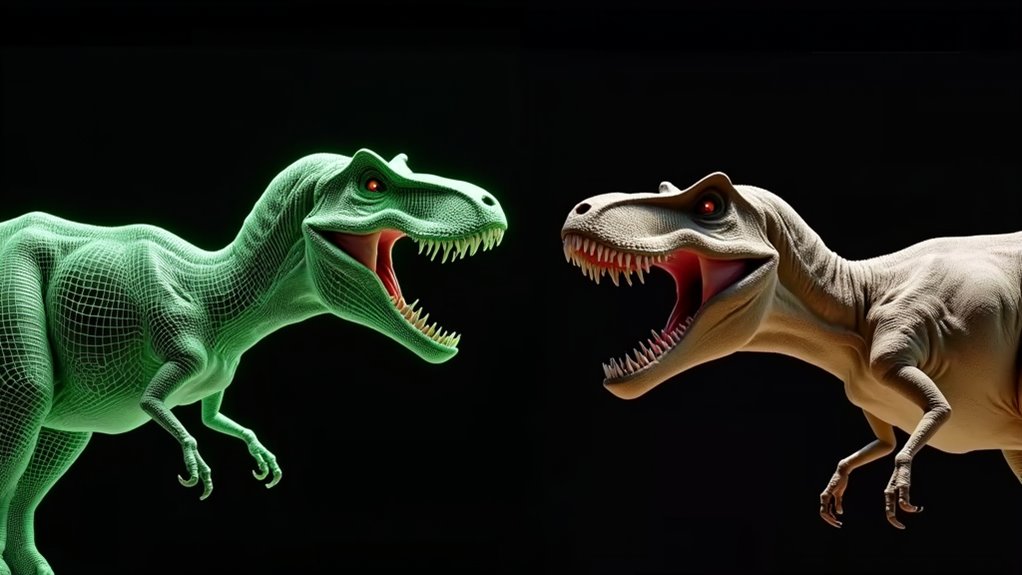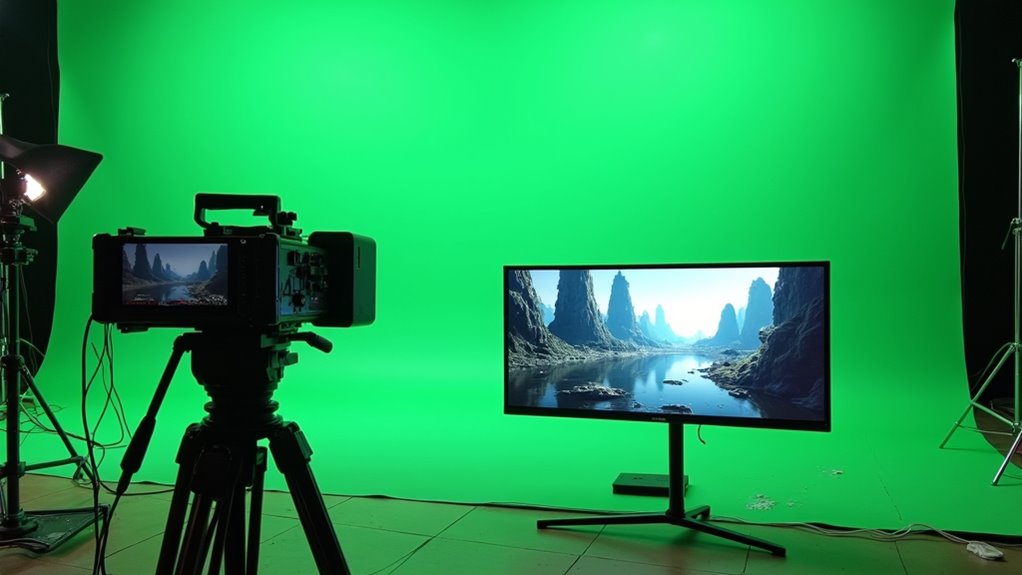CGI transformed filmmaking from its humble beginnings with pixelated graphics in the 1970s to today’s photorealistic spectacles, fundamentally changing how stories reach the screen. This evolution, starting with Westworld’s groundbreaking effects and accelerating through Star Wars’ iconic wireframes, enabled filmmakers to create previously impossible worlds and characters. Modern productions seamlessly blend digital elements with practical footage, while emerging technologies like AI and virtual reality push creative boundaries even further. The journey from simple computer graphics to immersive digital realms has only begun.
The Evolution of CGI: From Pixels to Photorealism

Since the early 1970s, computer-generated imagery (CGI) has transformed from rudimentary pixel graphics into the photorealistic marvels audiences take for granted today.
The journey began with Westworld’s groundbreaking digital animation, followed by Star Wars’ iconic wireframe graphics that made space battles look cutting-edge, at least by 1977 standards. Creating these early visuals required sophisticated computing power to render even basic images.
From primitive pixels to wireframe wonders, early CGI in Westworld and Star Wars revolutionized how audiences experienced sci-fi action.
The 1980s marked significant leaps forward, with Young Sherlock Holmes introducing the first photorealistic CGI character and Luxo Jr. mastering the art of digital shadows. The critically acclaimed film The Last Starfighter pioneered integrated CGI for spaceship sequences.
By the 1990s, CGI had evolved dramatically – Terminator 2’s liquid metal assassin moved with unprecedented realism, while Jurassic Park’s dinosaurs convinced viewers that extinct creatures could roam again. Early filmmakers also relied on matte paintings and miniatures to create stunning visual effects.
The technology reached new heights in the 2000s, culminating in Avatar’s fully realized digital world that blurred the line between reality and computer animation.
Modern developments like LED Volume Technology, showcased in The Mandalorian, continue pushing the boundaries of what’s possible in visual storytelling.
How CGI Revolutionized Visual Storytelling
The advent of CGI technology fundamentally transformed how stories could be told on screen, shattering the creative limitations that had constrained filmmakers for nearly a century. This digital revolution enabled directors to craft elaborate fantasy worlds and bring impossible characters to life, from the brooding complexity of Gollum to entire armies of mythical creatures that previously existed only in imagination.
Beyond mere visual spectacle, CGI revolutionized the very process of storytelling by allowing filmmakers to pre-visualize complex sequences and seamlessly blend digital elements with practical footage. The rise of accessible software has democratized CGI, enabling independent filmmakers to create stunning visual effects on modest budgets. Visual storytelling techniques have evolved to incorporate both traditional cinematography and digital innovations, creating a more dynamic narrative approach.
The technology’s sophistication in capturing subtle emotional performances through motion capture has elevated character development to new heights, while its ability to create immersive environments has transformed audience engagement. The evolution from practical effects and miniatures to digital techniques marked a pivotal shift in cinematic history.
Productions now routinely integrate CGI with traditional filmmaking techniques, creating a hybrid approach that combines the raw authenticity of practical effects with the limitless possibilities of digital enhancement, ultimately delivering more compelling and emotionally resonant narratives.
The Future of Digital Cinema: Merging Technology and Art

Digital cinema stands at the precipice of its most transformative era, where emerging technologies like virtual reality, artificial intelligence, and blockchain are fundamentally reshaping how stories reach the screen and connect with audiences.
The integration of AI-driven cinematography and real-time video processing is streamlining production workflows, while immersive technologies like VR and 360-degree video experiences are turning passive viewers into active participants in the storytelling process. The growing trend of immersive spaces in retail and entertainment venues is revolutionizing how audiences interact with digital content. The advancement of real-time graphics has revolutionized how filmmakers plan and execute complex visual scenes during production. Advanced deepfake technology is revolutionizing the way filmmakers approach casting and character creation.
The rise of streaming platforms and hybrid release models has sparked a revolution in content distribution, with blockchain technology ensuring transparent revenue sharing through smart contracts.
Meanwhile, advances in projection technology, particularly in Premium Large Format theaters, continue to push the boundaries of visual excellence.
As filmmakers experiment with interactive storytelling and hybrid techniques that blend animation with live action, the line between traditional cinema and digital art becomes increasingly blurred, promising a future where technology and creativity converge to create unprecedented cinematic experiences.
Frequently Asked Questions
How Much Does CGI Typically Cost in a Modern Blockbuster Movie?
Modern blockbuster movies typically invest around $33.7 million in CGI effects, though costs can surge dramatically for high-profile productions.
Films like Avatar and Avengers: Endgame, with their dazzling visual spectacles, pushed CGI budgets into stratospheric territory, exceeding $200-300 million.
Complex CGI sequences can cost upwards of $100,000 per minute, with factors like rendering requirements, artist expertise, and project scale driving expenses skyward.
Do Actors Perform Differently When Working With CGI Versus Traditional Sets?
Actors face distinct challenges when working with CGI versus traditional sets, requiring significant adjustments to their performance techniques.
While traditional sets allow natural interactions with physical environments and co-stars, CGI work demands heightened imagination and precise physical coordination.
Performers must rely heavily on visualization skills, often acting against tennis balls on sticks or in front of green screens, while maintaining emotional authenticity and believable reactions to non-existent elements.
Which Movies Have Used CGI Most Effectively While Staying Under Budget?
“Everything Everywhere All at Once” stands as a masterclass in budget-conscious CGI, creating 500+ effects shots with minimal resources.
“Ex Machina” achieved Oscar-winning robotics on just $15 million, while “Shape of Water” cleverly combined practical effects with strategic digital enhancements.
“District 9” maximized its modest budget through documentary-style filming and focused CGI use, proving that creativity often trumps massive spending in visual storytelling.
How Long Does It Take to Create Complex CGI Sequences?
Complex CGI sequences typically take 6-12 months to complete, with individual frames requiring anywhere from 8 to 40 hours of rendering time.
Major blockbusters like “Avatar” or “Avengers: Endgame” can spend years perfecting their CGI-heavy scenes, while smaller productions might compress this timeline to 3-4 months through efficient pre-planning and focused asset creation, though often with less elaborate results.
Can Older Movies Be Enhanced With Modern CGI Technology?
Modern CGI technology can effectively enhance older movies through various techniques, including improved rendering, sharper textures, and advanced motion capture.
While successful examples like the Star Wars Special Editions demonstrate this potential, the process requires careful consideration to maintain the original film’s artistic integrity.
Studios can update dated effects, enhance background elements, and refine character animations while preserving the nostalgic charm that made these classics memorable.
